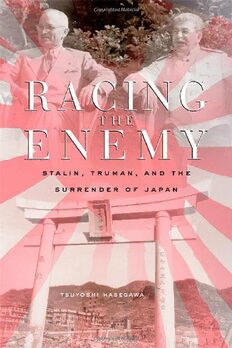
Racing the Enemy: Stalin, Truman, and the Surrender of Japan PDF
Preview Racing the Enemy: Stalin, Truman, and the Surrender of Japan
R A C I N G T H E E N E M Y R A C I N G T H E E N E M Y stalin, truman, and the surrender of japan tsuyoshi hasegawa the belknap press of harvard university press Cambridge,Massachusetts London,England • 2005 Copyright©2005bythePresidentandFellowsofHarvardCollege Allrightsreserved PrintedintheUnitedStatesofAmerica LibraryofCongressCataloging-in-PublicationData Hasegawa,Tsuyoshi,1941– Racingtheenemy : Stalin,Truman,andthesurrender ofJapan /TsuyoshiHasegawa. p. cm. Includesbibliographicalreferencesandindex. ISBN0-674-01693-9(alk.paper) 1.WorldWar,1939–1945—Armistices. 2.WorldWar,1939–1945—Japan. 3.WorldWar,1939–1945—SovietUnion. 4.WorldWar,1939–1945— UnitedStates. 5.Worldpolitics—1933–1945. I.Title. D813.J3H37 2005 940.53′2452—dc22 2004059786 Inmemoryof Boris Nikolaevich Slavinsky, myfriendandcolleague, whodidnotseethefruitofourcollaboration Contents Maps viii NoteonTransliterationandSpelling ix Introduction:RacetotheFinish 1 1. TriangularRelationsandthePacificWar 7 2. Stalin,Truman,andHirohitoFaceNewChallenges 45 3. DecisionsforWarandPeace 89 4. Potsdam:TheTurningPoint 130 5. TheAtomicBombsandSovietEntryintotheWar 177 6. JapanAcceptsUnconditionalSurrender 215 7. AugustStorm:TheSoviet-JapaneseWar andtheUnitedStates 252 Conclusion:AssessingtheRoadsNotTaken 290 Abbreviations 307 Notes 309 Acknowledgments 363 Index 367 Illustrationsfollowpages132and204 Maps 1 JapanatWar,1945 9 2 AugustStorm 196 3 CentralTokyo 246 4 Soviets’KurilOperation 257 5 BattleofShimushu 261 Note on Transliteration and Spelling For Russian words, I have used the Library of Congress translitera- tion system except for well-known terms such as Yalta and Mikoyan when they appear in the text; in the citations, I retain Ialtinskaia konferentsiiaandMikoian.Softsignsinpropernounsareomittedinthe text but retained in the notes; hence “Komsomolsk” instead of “Komsomol’sk.” I employ the strict Library of Congress transliteration system for the ending “ii” rather than the more popular ending “y”; hence “Maiskii” instead of “Maisky” and “Lozovskii” instead of “Lozovsky.” For Japanese words, I use the Hepburn transliteration system with somemodifications;hence“Konoe”insteadofthemorecommonlyused “Konoye.” But I use “nenpyo” instead of the strict Hepburn rendering “nempyo.” In addition, I use an apostrophe in some cases for ease of reading; for instance, “Shun’ichi” instead of “Shunichi,” to separate “shun”and“ichi.”MacronsinJapanesenamesandtermsareomitted. Japanese given names come before surnames in the text, but the or- der of surnames and given names follows the Japanese custom in the endnotes, except for Japanese authors of English- or Russian-language books and articles. For instance, Sadao Asada’s Japanese article is cited as“AsadaSadao,”buthisEnglisharticleiscitedas“SadaoAsada.” ForChinesegeographicalnamesIusethePostalAtlassystem.ForChi- nese personal names I follow contemporary style rather than the pinyin system; hence “Chiang Kai-shek” rather than “Jiang Jieshi,” and “T.V. Soong”ratherthan“SongZiwen.” ForpropernamesindirectquotesfromoriginaldocumentsIretainthe usage in the original, although these renderings may not conform to the systemIuseinthetext.Thus,the“Kurils”mayappearasthe“Kuriles” and“Konoe”as“Konoye”indirectquotes. ix
